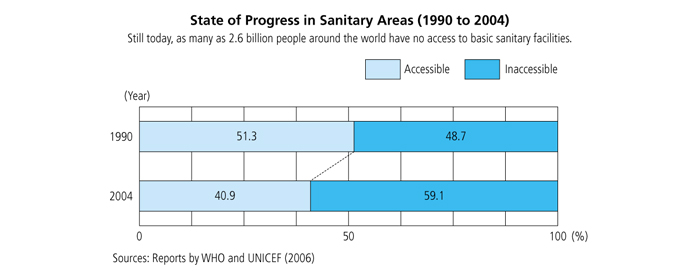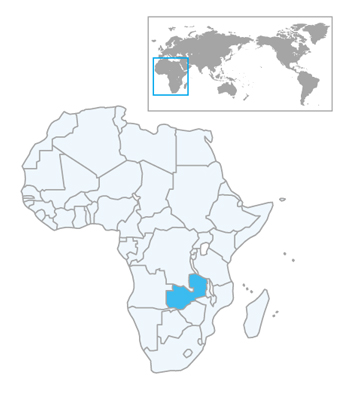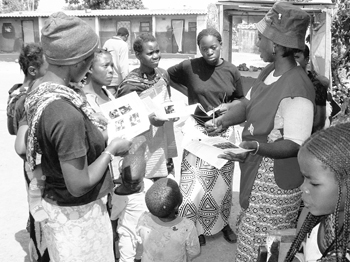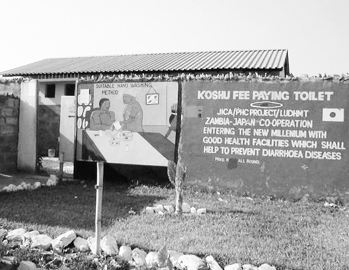Japan's Official Development Assistance White Paper 2007
Box 6. Japan's Efforts in the Water and Sanitation Sector — Toward the International Year of Sanitation 2008 —
The year 2008 marks the International Year of Sanitation adopted by the UN General Assembly. In December 2006, a draft resolution to declare 2008 as the International Year of Sanitation was submitted to, and unanimously adopted by, the UN General Assembly on the initiative of Japan. The International Year of Sanitation is aimed at enhancing efforts in the sanitation sector with targets of: (1) raising awareness of the people in the world on the importance of sanitation and providing various forms of assistance; and (2) designating a road map to lay out actions to be taken in 2008 and afterward by all parties involved in the assistance.
In our daily lives, it is difficult to imagine lacking access to a decent toilet or bathing facilities, or having to travel many kilometers just to get water. Some people in developed countries may take safe water and sanitation for granted, but access to water and sanitary facilities is not guaranteed in some developing countries. To ensure minimum cleanliness, health and human dignity, at least 20 liters of water per day per person from a source within one kilometer of the person's home is needed. In reality, approximately 1.1 billion people live more than one kilometer away from their water sources, consume only five liters of water per day, which in many cases is not necessarily of safe quality.*1
Securing safe drinking water and issues related to sanitation including waste water treatment through sewage toilet facilities are two sides of the same coin. In order to secure safe drinking water, it is crucial to manage waste water and excretions adequately to separate them from sources of drinking water. The Human Development Report 2006 states that about 1.8 million children die each year from water-borne diseases caused by unclean water and poor sanitation. Unsanitary water is the world's second biggest killer of children.*2
It is not only problems directly linked to people's health that are caused by the lack of safe drinking water and adequate sanitation. At the World Children's Water Forum, held in Shiga, Japan in March 2003, a student from Bangladesh reported that almost half of schools in the country lacked sanitary facilities like toilets and hand wash stations. For example, a local school of 1,200 students had only one toilet, forcing many students to not attend school, as they were unable to bear the poor sanitary conditions. It is a grave situation when children, who will play an important role for their country's future, cannot go to school simply because of the lack of school toilets and thus lose their educational opportunities.
To tackle issues in the water and sanitation sector, the MDG target for drinking water and sanitation aims at halving, by 2015, the proportion of people without sustainable access to safe drinking water and basic sanitation. Although the percentage of population without access to water improved from 52% to 41%, in 1990 and 2004 respectively, about 1.1 billion people in the world are still unable to access safe drinking water, while about 2.6 billion are unable to access sanitary facilities, meaning that further efforts need to be devoted to this problem.
In response, Japan has for a long time identified water and sanitation as key areas, providing official development assistance programs that utilize Japan's various technologies and knowledge. In the 1990s, Japan was the top donor among the major donor countries. Japan contributed a total of $4.88 billion between 2001 and 2005, which accounted for 37% of bilateral assistance. Behind these efforts is the fact that Japan has experienced water-related natural disasters such as typhoons and concentrated heavy rains, as well as water contamination and other types of water-related pollution. As a result, Japan has a long record of controlling floods and managing water quality, which can be drawn upon when assisting other countries. For example, in Peru, Japan provided a grant aid program to improve the water supply infrastructure to provide clean drinking water since 2000, targeting northern Piura and Tumbes Regions, where social infrastructure had long been underdeveloped. As a result of digging new wells, rehabilitating existing ones and providing water tank trucks, Piura Region saw a rise of water supply from 40% before the project to 83% in its urban areas and 60% in local areas, both of which are above the national average of 76% and 57% respectively. While the project's initial goal was to provide water services to 35,000 residents by tank trucks, more than 100,000 residents received the service as of July 2006, meaning significant achievements had been made.
Building on these achievements, Japan now focuses on emphasizing activities to raise awareness for sanitation, which is considered as soft-aspect assistance, in addition to hard-aspect assistance such as infrastructure building. This is based on the fact that sanitation facilities, including public toilets, once provided by Japan's development assistance, were not properly utilized due to their lack of understanding. JICA is now preparing educational materials on hygiene, contemplating modalities of cooperation that emphasize awareness-raising activities based on the social and cultural backgrounds of each local area and calling on local residents for improvements in sanitary situations through reviews of daily behaviors. Marking the International Year for Sanitation as a milestone, and in cooperation with the international society, Japan will continue to actively work on assistance in the water and sanitation sector as the world's largest donor in this sector.

Japan's Contribution to Water Supply and Sanitation Sector: "Koshu" Toilets in Zambia
While public toilets are used as ordinary facilities in Japan, there are scarcely any of them in Zambia. As one of the poorest countries in Africa, Zambia has seen little progress in its social infrastructure development. With litter left uncollected and toilets consisting of mere holes in the ground, many local residents are affected by insufficient hygiene and sanitary conditions.
From 1997, Japan launched a technical cooperation project led by JICA in the deprived areas of the Zambian capital, Lusaka, to help address the situation. The objective of the project was to help local residents become capable of protecting their own health. The JICA project included a component for hygiene education, installment of household toilets, improvement of drainage channels and cleaning up of litter in a participatory way. JICA also assisted the installation of public toilets, showers and other facilities. By charging fees to use the public toilets, the program organizers were able to generate funds for their maintenance and pay for activities of volunteer residents engaging in education for health and sanitation. With dedicated instruction by experts from Japan, the residents enhanced their awareness, which has led to not only the use of public toilets but also improvement of family sanitary behaviors.
As a result of these aid activities, the incidence of malnourishment and diarrhea among children dropped below 40% during the period from 2004 to 2005, attesting to tangible achievements. Even today, these public toilets remain as familiar facilities dubbed "Koshu," the Japanese word for "public."


A trained volunteer resident explaining sanitary principles to her fellow residents (Photo: JICA)

Flush toilets dubbed "Koshu," decorated with murals created by local elementary school children
While public toilets are used as ordinary facilities in Japan, there are scarcely any of them in Zambia. As one of the poorest countries in Africa, Zambia has seen little progress in its social infrastructure development. With litter left uncollected and toilets consisting of mere holes in the ground, many local residents are affected by insufficient hygiene and sanitary conditions.
From 1997, Japan launched a technical cooperation project led by JICA in the deprived areas of the Zambian capital, Lusaka, to help address the situation. The objective of the project was to help local residents become capable of protecting their own health. The JICA project included a component for hygiene education, installment of household toilets, improvement of drainage channels and cleaning up of litter in a participatory way. JICA also assisted the installation of public toilets, showers and other facilities. By charging fees to use the public toilets, the program organizers were able to generate funds for their maintenance and pay for activities of volunteer residents engaging in education for health and sanitation. With dedicated instruction by experts from Japan, the residents enhanced their awareness, which has led to not only the use of public toilets but also improvement of family sanitary behaviors.
As a result of these aid activities, the incidence of malnourishment and diarrhea among children dropped below 40% during the period from 2004 to 2005, attesting to tangible achievements. Even today, these public toilets remain as familiar facilities dubbed "Koshu," the Japanese word for "public."


A trained volunteer resident explaining sanitary principles to her fellow residents (Photo: JICA)

Flush toilets dubbed "Koshu," decorated with murals created by local elementary school children


 Next Page
Next Page